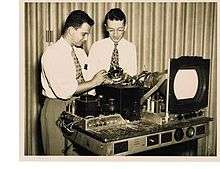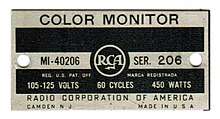Fred Bechly
Fred Lorin Bechly (May 8, 1924 – October 31, 2004) was an American electrical engineer and inventor in the field of color television broadcasting.
Fred Lorin Bechly | |
|---|---|
 H.J. Benzuly (left) and F.L. Bechly with the RCA Tri-color Kinescope Monitor (1952) | |
| Born | May 8, 1924 |
| Died | October 31, 2004 (aged 80) |
| Resting place | Westminister Presbyterian Church Memorial Garden in Wilmington, Delaware |
| Nationality | United States |
| Occupation | Electrical Engineer |
| Known for | Color Video Technology |
Early life
Fred Bechly was born in Watseka, Illinois, United States, to Edward Bechly (1874–1945) and Ferne Smiley (1887–1968). He married and had two children.[1]
In 1944, Bechly graduated from the University of Illinois with a Bachelor of Science in Electrical Engineering. As a student, Bechly was a member of Triangle Fraternity, and the American Institute of Electrical Engineers.[2]
Career
Fred Bechly began his career at RCA Corporation in Camden, New Jersey in 1944, and he worked there for 40 years in the field of color television broadcasting.[3]
Bechly was recognized early in his career, along with engineer H.J. Benzuly, for development of the Tri-color Kinescope Monitor. This development offered significant advantage over the RCA prior technology that used three kinescopes which combined three images using a mirror system to produce a single color picture.[4] The RCA 'mirror system' had been judged inferior to the CBS 'mechanical method' by the Federal Communications Commission.[5] The new Tri-color Kinescope technology was considered to be the RCA "secret weapon" vs. competitor CBS during establishment of the NTSC standard for color television by the U.S. Federal Communications Commission in 1953.[6] RCA assigned model MI-40206 as the prototype which used the NTSC standard as its input.[7][8] RCA ultimately prevailed with the NTSC standard on December 17, 1953. The Tri-color Kinescope Monitor was then commercialized to become the RCA TM-10A Color Monitor, which was the prototype for subsequent versions of the cathode ray tube color monitor in common use thereafter.[9][10]

In 1975, Bechly received a special achievement award for outstanding contribution to the RCA TR-600 (color video recorder) program.[11][12][13]
Bechly was confirmed as a Life Member of the Institute of Electrical and Electronics Engineers (IEEE).[14]
Inventor
Fred Bechly was granted two United States patents, that were important to the field of color television broadcasting, as an employee of the RCA Corporation.
U.S. Patent # 2,874,212 was granted February 17, 1959 for Generation of Color Images from Monochrome Television Signals.[15] This technology was applied commercially with the RCA Color Synthesizer program.[16]
U.S. Patent # 3,893,168 was granted July 1, 1975 for Technique for Minimizing Interference in Video Recorder Reproducer Systems. Jing Jue Young was co-applicant for this patent.[17] This technology was applied commercially with the RCA TR-600 program.[11]
Mr. Bechly began work on a third patent for Tracking Head in support of the technology associated with the TR-800 project, but the rapid pace of technical advancement in video recording equipment at that time eclipsed the need for patent protection on the project.
Emmy nomination
Fred Bechly was a member of the RCA Corporation team that was nominated for the 1958-1959 award of the National Academy of Television Arts and Sciences for Development of Color Video Tape.
The Emmy Award was a combination of several nominations described as "Industry-wide improvement of editing of Video Tape as exemplified by ABC – CBS – NBC".[18]
Death
Bechly died in West Chester, Pennsylvania on October 31, 2004, at the age of 80. He was buried in Westminister Presbyterian Church Memorial Garden in Wilmington, Delaware.[1]
See also
References
- Findagrave memorial for Fred Lorin Bechly.
- The Illio (University of Illinois yearbook), p.64, 1944
- RCA Family, December 1969, Camden, New Jersey
- J. Burgess Davis, Broadcast Studio Engineering, pp. 34-35, RCA Engineers Digest, November 1952, University of Minnesota Library.
- Gen. Sarnoff of RCA: Besieged on Three Fronts, Cover story, pp. 62-63 (Electronic vs. Mechanical), Newsweek Magazine, December 5, 1949.
- RCA's Sarnoff "Who would dare predict the future?", Cover story, p.74 (Secret Weapon), Time Magazine, July 23, 1951.
- Preliminary Specification MI-40206 Color Monitor, F. L. Bechly, June 1953, David Sarnoff Library Collection, Hagley Museum and Library
- Radio Corporation of America., United States. Federal Communications Commission., National Broadcasting Company. (1953). Petition of Radio Corporation of America and National Broadcasting Company, inc. for approval of color standards for the RCA color television system. p.478-481.
- A.H. Lind, RCA Color TV Monitor, pp. 72-75, RCA Broadcast News, Vol. 77, January 1954.
- You're Ready for Color TV Because RCA is Ready for You, RCA Corporation advertisement, May 1954, David Sarnoff Library Collection, Hagley Museum and Library.
- RCA Family, August 1975, Camden, NJ
- RCA Broadcast News, inside cover, Vol. 158, June 1976.
- TR-600, The Broadcast Archives.
- IEEE certificate, Fred Bechly file archive, David Sarnoff Library Collection, Hagley Museum and Library
- United States patent #2,874,212.
- C.R. Monro, RCA Color Synthesizer and how it works, pp. 26-31, RCA Broadcast News, Vol. 111, June 1961.
- United States patent #3,893,168.
- 1958–1959 NATAS award for Outstanding Achievement Archived 2012-09-16 at the Wayback Machine, Emmy Award.